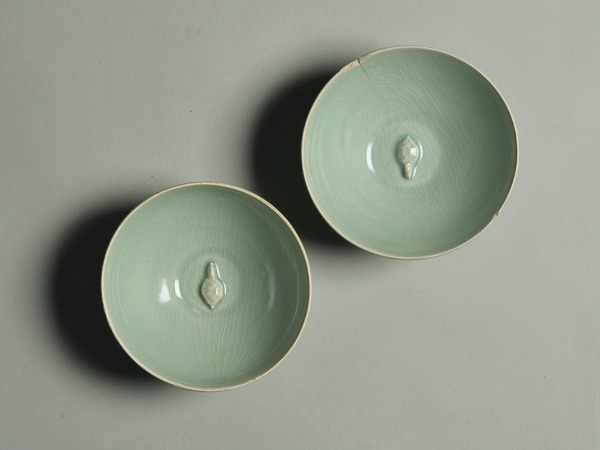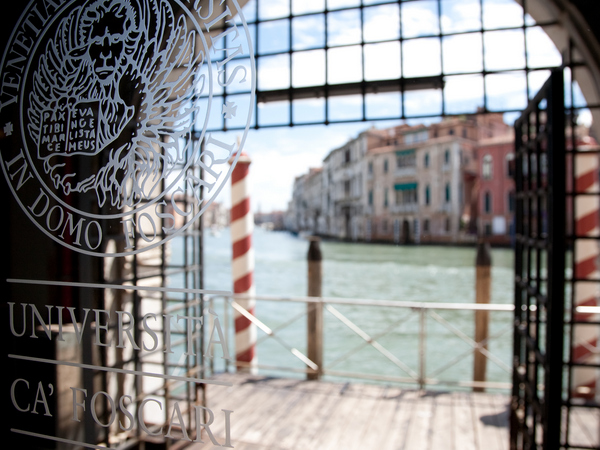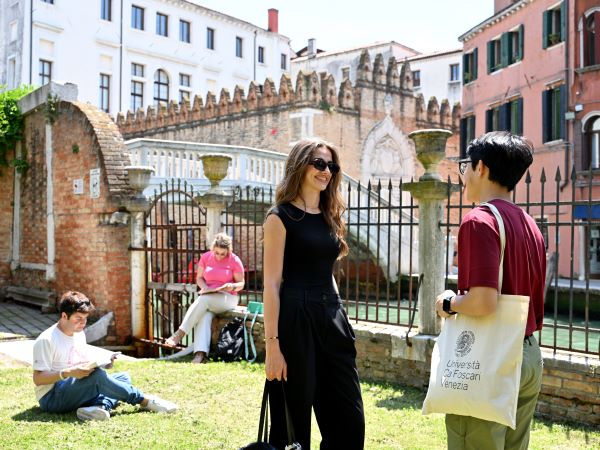Vivid Transparencies: Yaozhou ceramics from the Shang Shan Tang Collection is a ceramics exhibition organised by Fondazione Università Ca' Foscari and MAOV entirely dedicated to the manufactures of Yaozhou, a district about 100 km north of Xi'an, in northern China (where the First Emperor's famous Terracotta Army is located). It will be held at the Venice Museum of Oriental Art from 7 September to 23 October 2022.
The Department of Asian and Mediterranean African Studies of the Ca' Foscari University of Venice and the Museum of Oriental Art of the Veneto Museums Regional Directorate are once again collaborating to organise events with a high scientific and popular profile, as part of a synergy of intentions that is both useful and necessary for the dissemination of knowledge of non-European cultures.
The Yaozhou kiln, which was active between the 8th and 13th centuries, revolutionised the production of celadon ceramics, becoming the most influential factory in the entire empire. When it comes to ceramics, China holds several records: it was the first country to invent porcelain in the late 6th and early 7th century (whereas in Europe it was done a thousand years later by alchemists at the court of Augustus the Strong (1670-1733) in Meissen). However, in the 13th century BC, objects had already been produced featuring a highly refractory body coated with a layer of green glaze (in various shades), commonly known as celadon in the West and qingci (stoneware with blue-green glaze) in China. This kind of ceramic has enjoyed enormous success precisely because of its blue-green hues, which are reminiscent of jade, China's iconic material, or the patina on ancient bronzes, another emblem of China's millenary civilisation.
The 96 works on display all come from a foreign private collection, the上善堂 Shang Shan Tang – literally 'Hall of the Supreme Good' –, which includes one of the most comprehensive collections of Yaozhou ceramics in the world, with specimens of excellent quality testifying to the evolution of the manufacture.
All the pieces will be exhibited in the impressive Room 12 of the Museum of Oriental Art, which was intended to house the Chinese porcelain from what was once the collection of Henry of Bourbon in 1928. The historical set-up designed by Nino Barbantini has been preserved ever since and harmonises the extraordinary Asian pieces with the surrounding rococo environment, which is adorned with 18th century mirrors and stuccoes, creating a fascinating ambience.
The kiln of wonders
The history of the Yaozhou kiln is surprising: originally a modest factory, by the 10th century it had already specialised in the production of high quality celadon (until then the prerogative of southern manufactories) through a series of technological breakthroughs dictated by the need to resolve defects and drawbacks. Known later mainly for the manufacture of olive-green celadon with decorative motifs engraved or embossed under the glaze, it had been established to produce black-covered ceramics for everyday domestic use and the polychrome sancai ('three-coloured') glaze kind, intended mostly for funerary furnishings. Northern China was known for porcelain production, and craftsmen in Yaozhou also tried their hand at making white ceramic (false porcelain), as made by covering the impurities in the body clays with a layer of white engobe before applying the colourless transparent glaze. The results, however, were disappointing: rather than white, the glaze was an unattractive yellow, prompting the kiln workers to venture into the complex – and unfamiliar – system of firing in a reducing (oxygen-free) atmosphere. Chemical analyses showed that the recipe for body and glaze remained unchanged, but thanks to the reducing firing, the glaze turned out a more than satisfactory green when the titanium in the engobe did not interfere, thus yellowing it. To overcome this problem, ceramists began to completely cover the objects first with white engobe and then with glaze. However, this method presented another challenge, as during firing, the glaze becomes a very powerful glue, making it necessary to limit as much as possible the points of contact of the foot of each object with the bottom of the container in which it was placed for firing. Here again, the ceramists of Yaozhou showed great ingenuity by progressively refining the technique until they devised one that left only three small scars on the base. This practice is commonly associated with the celebrated Ru ceramics (produced for a hundred years starting from the end of the 11th century) and considered as a great achievement of the ceramists of Ru, but in fact it was their colleagues in Yaozhou who invented it a hundred and fifty years earlier. A new challenge arose in the 11th century, when the kiln workers adopted charcoal (replacing the scarce wood) as a fuel to fuel the kilns. The different yield of coal compared to wood imposed significant changes to the layout of the kilns, while the rapid cooling at the end of the firing cycle ensured transparent glazes (as opposed to the earlier translucent ones). Transparency was needed for the decorative motifs found on the body underneath to be clearly readable: in fact, the new aesthetic taste favoured intensely ornamented objects, but, under a translucent blanket, the decorations appeared hazy; therefore, the Yaozhou stokers took advantage of the full maturity reached by the glazes fired in the coal-fired kilns by cooling them rapidly. As to the olive-green hue that characterises the glazes of this period, recent chemical analyses have shown a change in the recipe, probably due to the composition of the local raw materials, characterised by an increase in the percentage of titanium, which is responsible for this hue.
Opaline glazing made a comeback in the late 11th and early 12th century with Ru ceramics, which was much appreciated by the emperor Song Huizong (r. 1100-1126), who wanted to use them at court. Once again, the ceramists of Yaozhou were able to respond promptly to the new fashion, creating the so-called 'moonlight' glaze, i.e., a glaze similar to jade, translucent, shiny, soft, and characterised by a very subtle shade of green (as opposed to the light blue typical of Ru pieces). In the 13th century, the Yaozhou manufactories fell into disuse, only to be rediscovered through a series of archaeological campaigns – especially in the 1990s – that demonstrated their crucial role in the development of Chinese ceramic history.
From technology to decorative themes
To fully appreciate the production of Yaozhou, the exhibition is organised by themes, the first being technology in order to capture the sophistication of the experiments carried out over time by the Yaozhou ceramists, who were always ready to take up the challenges posed by the intrinsic characteristics of the local raw materials, constantly innovate production and to adapt the fashions of the moment. Some display cases are centred around the carved, engraved or embossed decorative motifs that distinguish the Yaozhou celadons: peonies (a metaphor for female sensuality), chrysanthemums (a symbol of autumn and the wisdom one acquires over the years), lotuses (introduced with Buddhism), children at play (a wish for numerous offspring and unbroken lineage), mandarin ducks in a pond (emblem of marital fidelity), and miniature sculptures of turtles applied to the bottom of small cups; these latter were to look as though they were swimming in the liquor poured into the cups, thus evoking extraordinary myths and stories. Other showcases focus on the function of the shapes used in domestic, but also religious (especially Buddhist) contexts. One display case is dedicated to specimens marked with inscriptions, one of which is of particular importance, as it indicates that already by the time of the Five Dynasties (907-960), the kilns of Yaozhou had achieved excellence in the manufacture of celadon, so much so that they were included in the tribute system for the imperial court. While the Yaozhou manufactures are famous for their olive-green ceramics, it is important to emphasise that they also excelled in the production of the rust-red and black kinds, the latter either monochrome or mottled in red with a very modern effect; indeed, a display case showcases the various types by highlighting their colours.
For further reading, see Sabrina Rastelli, 'Re-emerging from underground: The great achievements of the Yaozhou kilns through their archaeological investigation'.
INFORMATION
VIVACI TRASPARENZE, Ceramiche di Yaozhou dalla Collezione Shang Shan Tang (Vivid Transparencies, Yaozhou ceramics from the Shang Shan Tang Collection). Open from 7 September 2022 to 23 October 2022.
PRESS PREVIEW on 7 September from 11:00 to 12:00.
To register, please fill in this form: forms.gle/h4qibbdgQ8hKfV8E7
INAUGURATION on 7 September from 17:00 to 19:00. Free entry.
CURATOR
Professor Sabrina Rastelli Phd, Full Professor of Chinese Art and Archaeology at Ca’ Foscari University of Venice
WHERE
MAOV Museo d’Arte Orientale di Venezia
Ca’ Pesaro, Sestiere di Santa Croce n. 2076, Venezia
OPENING TIMES
10:00 — 18:00, Tuesday-Sunday
The exhibition is included in the museum entry ticket.
ORGANISED BY
Fondazione Università Ca’ Foscari – MAOV Museo d’Arte Orientale di Venezia











